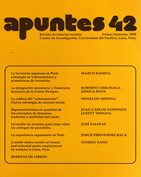A Multi-Choice Model Of Formal And Informal Sector Employment By Woman In Lima, Peru
DOI:
https://doi.org/10.21678/apuntes.42.473Keywords:
Peru, econometrics, labor market, womanAbstract
Using the multinomial logit (MNL) models, this research has verified the heterogeneity of the urban informal employment sector and the significance of informal wage work for female workers in Lima; Peru. For the analysis of female labor supply, women aged 15-65 in Lima are disaggregated into the seven occupations: non-working, unpaid family work, domestic work, informal wage work, self-employment, formal private sector work, and formal public sector work.
The theory of the new household economics is used to identify the determinants of women's labor market participation and occupation choice. The descriptive analysis shows that informal wage workers are young and the most educated workers are in the informal sector. The empirical analysis indicates that informal sector work is not homogeneous such that it creates different employment opportunities to female worker in Lima. The further research on informal wage work in urban area is critical to understand the gray area between formal and informal sectors, and the development of urban economy.
Downloads
Downloads
Published
How to Cite
Issue
Section
License
Apuntes publishes all its articles and reviews under a Creative Commons Attribution (CC BY 4.0) license with the objective of promoting academic exchange worldwide. Therefore, articles and book reviews can be distributed, edited, amended, etc., as the author sees fit. The only condition is that the name of the author(s) and Apuntes. Revista de Ciencias Sociales (as the publisher) be cited.



.jpg)
